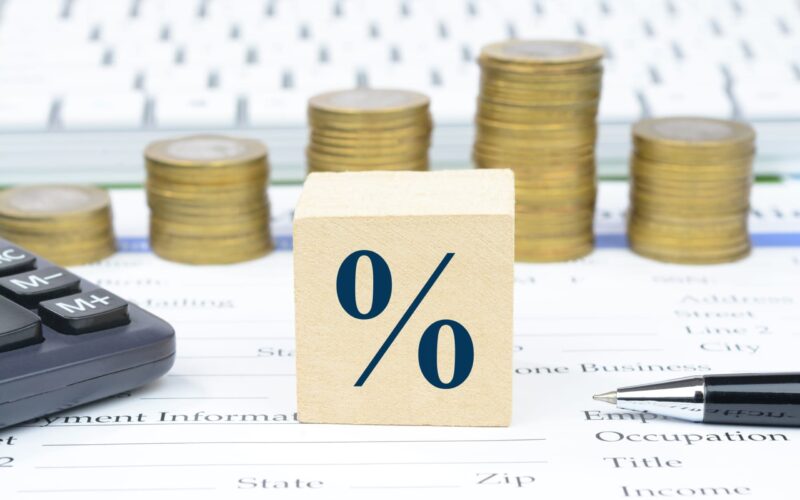In a nutshell, interest is the extra money you get after lending out your money to a borrower for a specific purpose. This post will be discussing various ways interest plays out like how interest does work generally and on a mortgage, a car loan/loans, and a savings account.
HOW DOES INTEREST WORK
Firstly, interest by economics and finance is payment from a borrower or deposit-taking financial institution to a lender or depositor of an amount above repayment of the principal sum, at a particular rate. Also shows when you borrow money, and therefore, the cost of doing borrowing is typically expressed as an annual percentage of the loan (or amount of credit card borrowing).
Likewise, when you save money it is the rate your bank or building society will pay you to borrow your money. The money you earn on your savings is also called interest. So, you see the term ‘interest’ serves a lot of purposes depending on what its application installs.
As for the question of how interest does work, I’m here today to tell you interest works in different ways for different purposes. For instance, it works on cars, mortgages, properties, and even for banks differently. Consequently, how does interest work for all these above mentions, well that’s our point of discussion from here forward.
HOW DOES INTEREST WORK ON A MORTGAGE
Furthermore, as I mentioned above, interest works for various purposes and one of them includes interest for a mortgage. you might want to know how interest does work on a mortgage.
A mortgage is an agreement between you and a lender that gives the lender the right to take your property if you fail to repay the money you’ve borrowed plus interest.
Also, note that mortgage loans are mostly put in use to buy a home or to borrow money against the value of a home you already own. However, how interest on a mortgage does work, depends on the type of mortgage you wish to take out.
The two basic types of mortgage include fixed and adjustable-rate loans. Furthermore, understand that how the interest rate work on your mortgage will depend on such factors as the type of loan and the length of the loan term (such as 20 or 30 years).
HOW MORTGAGE INTEREST IS CALCULATED
With most mortgages, you pay back a portion of the amount you borrowed (the principal) plus interest every month. Your lender also uses an amortization formula to create a payment schedule that breaks down each payment into principal and interest.
If you make payments according to the loan’s amortization schedule, the loan will be fully paid off by the end of its set term, such as 30 years. Furthermore, the mortgage is a fixed-rate loan, each payment will be an equal dollar amount.
If the mortgage is an adjustable-rate loan, the payment will change periodically as the interest rate on the loan changes.
Formula is as demonstrated with this example thus:
M = Pr (1 + r)n(1 + rn) – 1
M = the total monthly mortgage payment
P = the principal loan amount
R = monthly interest rate. Lenders provide you with an annual rate so you’ll need to divide that figure by 12 (the number of months in a year) to get the monthly rate.
N = number of payments over the loan’s lifetime. Multiply the number of years in your loan term by 12 (the number of months in a year) to get the number of total payments for your loan.
HOW DOES INTEREST WORK ON CAR LOANS
Car loans are common and as well popularly in use. A car loan interest is what you pay to borrow money from a lender when you finance the purchase of a vehicle; which is basically how interest work on car loans in general.
Here are the steps you should take in calculating your interest on car loans or trying to grasp how interest work generally on car loans: For first time payment:
- Divide your interest rate by the number of monthly payments per year.
- Multiply the monthly payment by the balance of your loan. However, for the first payment, this will be your total principal amount.
- The amount you calculate is the interest rate you will pay for your first month’s payment.
To calculate future auto loan interest payments, you will need a different calculation:
- Subtract the interest from your current debt. The amount left is what you owe towards your loan principal.
- Deduct the above amount from your original principal to get your new loan balance.
The calculation is an estimate of what you will pay towards an auto loan. Use the amount as a reference or guideline; it may not be the same amount you receive.
Mathematically: EMI is calculated as under:
P x R x (1+R)^N / [(1+R)^N-1]
- P = Principal amount of the loan
- R = Rate of interest
- N = Number of monthly installments.
HOW DOES INTEREST WORK ON A SAVINGS ACCOUNT
Interest as we have been discussing above is put in a calculation in different ways depending on where we are talking about it. Here, we are discussing how to work interest on a savings account.
Most of us operate a savings account yet we don’t know how interest on our savings account does work. Consider this post as an eye-opener into the knowledge of how interest does work on your savings account.
Firstly, we know that a savings account is an interest-bearing deposit account in possession of a bank or any other financial institution. A good number of people use this account because of its benefits. Among many includes a good option for emergency or short-term cash.
In exchange, savings accounts attract low-interest rates as well. The interest you earn on a savings account is considered taxable income. In fact, this account is in view as in use for short-term purposes such as buying a car, vacation, etc.
How interest on a savings account works thus implies that you earn interest in a savings account, that the bank is literally paying you money to keep your cash in deposit there. The type of interest your savings account earn, however, is called compound interest.
This means the interest you earn in one period gets in a deposit into your account, and then in the next period, you earn interest on that interest. However, calculating exactly how much interest your deposits earn overtime requires accounting for compound interest.
Here is a formula for calculating your compound interest on your savings account: For 12 months: Use the formula A=P(1+r/n)^nt, where:
- A = Ending amount.
- P = Principal amount (the beginning balance).
- R = Interest rate (as a decimal).
- N = Number of times interest is compounded in a specific time frame.
- T= Time frame.
Also, for a quick calculation of simple interest on your savings, use this formula: Interest = P x R x N.
- P = Principal amount (the beginning balance).
- R = Interest rate (usually per year, expressed as a decimal).
- N = number of time periods (generally one-year time periods).
For example, if you have a savings account with $10,000 that earns 1% interest per year. Express it as a decimal, the interest rate is 0.01, so the formula would be:
Interest = $10,000 x 0.01 x 1, which equals $100.
HOW DOES INTEREST WORK ON LOANS
As already known interest is one of the primary ways that lenders, banks, and credit card issuers earn a profit. Because typically getting a loan is incurring interest which is profitable to the lender.
For instance, when you borrow money, you are expected to pay back the funds over time. However, lenders expect to get something for their services and the risk they take when lending you money. which simply means that you won’t just pay back the money you borrowed, but You’ll pay back the loan plus an additional sum, which is interest.
In order to maximize profit for themselves, lenders use different forms and ways when charging for interest. Calculating loan interest can be difficult, as some types of interest require more math. Here are formulas that will put you through:
Simple interest: Principal loan amount x Interest rate x Time (Number of years in term) = Interest
Amortizing loan:
Factors that affect interest rates
It’s important you make proper research before diving into loans for any purpose. Knowing your interest rates is not enough, find the best lender for the type of loan you want to take.
Here are some factors that could affect your interest rate while taking out a loan:
Escrow Preference
Some lenders require escrows for residential or consumer loans. This means specific money put aside to pay for things like taxes, insurance, etc. If you choose not to escrow, your rate could be higher due to higher risk.
Closing Date
Depending on the market disposition, it can be important to lock in on a rate that is as close to your closing date as possible. The longer the rate lock period, the higher the rate will be.
Occupancy Type
Typically, rental or investment properties have higher interest rates.
Residency
Rates will be lower if you plan to live in the house full-time versus using it as a second home.
Available Assets
What additional assets do you have as possible collateral? The more down payment you have, usually the lower the rate.
Asset Seasoning
How long have you had your assets? There may be restrictions for assets owned under a certain time frame that could affect the rate.
Housing Ratio
What does the ratio from above look like when you add in the cost of the mortgage? Usually, a good housing ratio is 28%.
Improvements Needed
This will affect the value of the property. Remember that the lower the percentage of the loan amount to the value of the property, typically the better the rate.
Employment History
This also affects the risk to the lender. If you show a consistent history of employment, a better chance of a lower rate.
Relocation
Are you being temporarily or permanently relocated by an employer? That will determine if the house is considered a secondary (higher rate) or primary residence (lower rate).
Seller Contributions
If the seller is able to contribute money towards closing costs, that will increase the amount you have available for a down payment.
Gifts
Again, lowering the amount of loan you’ll need with gifts from family members will help to lower the interest rate.
Cash-out
If you refinance and want to walk away from closing with money in your pocket, you may be increasing the percentage of the loan to property value.
Combined Loan-to-Value (CLTV)
This ratio includes not only the current loan you are wanting but any additional loans on the property, such as home equity.
What are the 3 types of interest?
Simple (regular) interest, accumulated interest, and compound interest are the three different kinds of interest.
How does interest work each month?
You would divide 0.06 by 12 to get 0.005 if you had a monthly payment schedule and an interest rate of 6%. To calculate the amount of interest you will be required to pay that month, multiply that amount by the outstanding loan balance. The initial interest payment for a loan with a $5,000 amount would be $25.
What is interest in money?
When you borrow money or lend money, you are paying interest. The proportion of the loan amount used by lenders to compute interest. By lending money (via a bond or certificate of deposit, for example), or by depositing money into an interest-bearing bank account, consumers can earn interest.
Is interest just free money?
Simply explained, interest is the cost of borrowing money, whether it be through a credit card, mortgage, or school loan. When you borrow money, you often have to pay it back plus interest, which is typically a specified percentage of the loan amount.
Does interest earn monthly?
Although income is normally credited to the account once per month, you can earn interest every day with the majority of savings and money market accounts.
CONCLUSION
In conclusion, how interest work on mortgages, car loan/loans, savings accounts, and general loans differ in one way the other. So, it’s best if you have a good knowledge of the purpose you are willing to take out a loan. This will save you a ton of stress in the long run.
FAQS
How do interest rates work?
An interest rate tells you how high the cost of borrowing is, or high the rewards are for saving. So, if you’re a borrower, the interest rate is the amount you are charged for borrowing money, shown as a percentage of the total amount of the loan.
How does interest WORK example?
For example, if you borrow $5,000 at a simple interest rate of 3% for five years, you’ll pay a total of $750 in interest. The formula for simple interest is A = P (1 + rt). A is how much you pay over the total life of the loan, including interest. P is the principal amount.
How does interest make you money?
Interest on a savings account is the amount of money a bank or financial institution pays a depositor for holding their money with the bank. In a way, a bank borrows money from their depositors by using the deposited funds to lend money to other customers.
RELATED ARTICLES
- DEPRECIATION ACCOUNTING: Definition, Methods, Formula & All You Should Know
- SPIN Selling: Detailed Guide to the SPIN Selling Strategy
- PRINCIPAL PLACE OF BUSINESS LLC: Definition & Examples
- SHORT-TERM SOURCES OF FINANCE: BEST OPTIONS FOR ANY BUSINESS (+DETAILED GUIDE)
- Invest Money: The Best Way To Invest Money 2023
- ABC ACCOUNTING: Best Practices & All You Need






